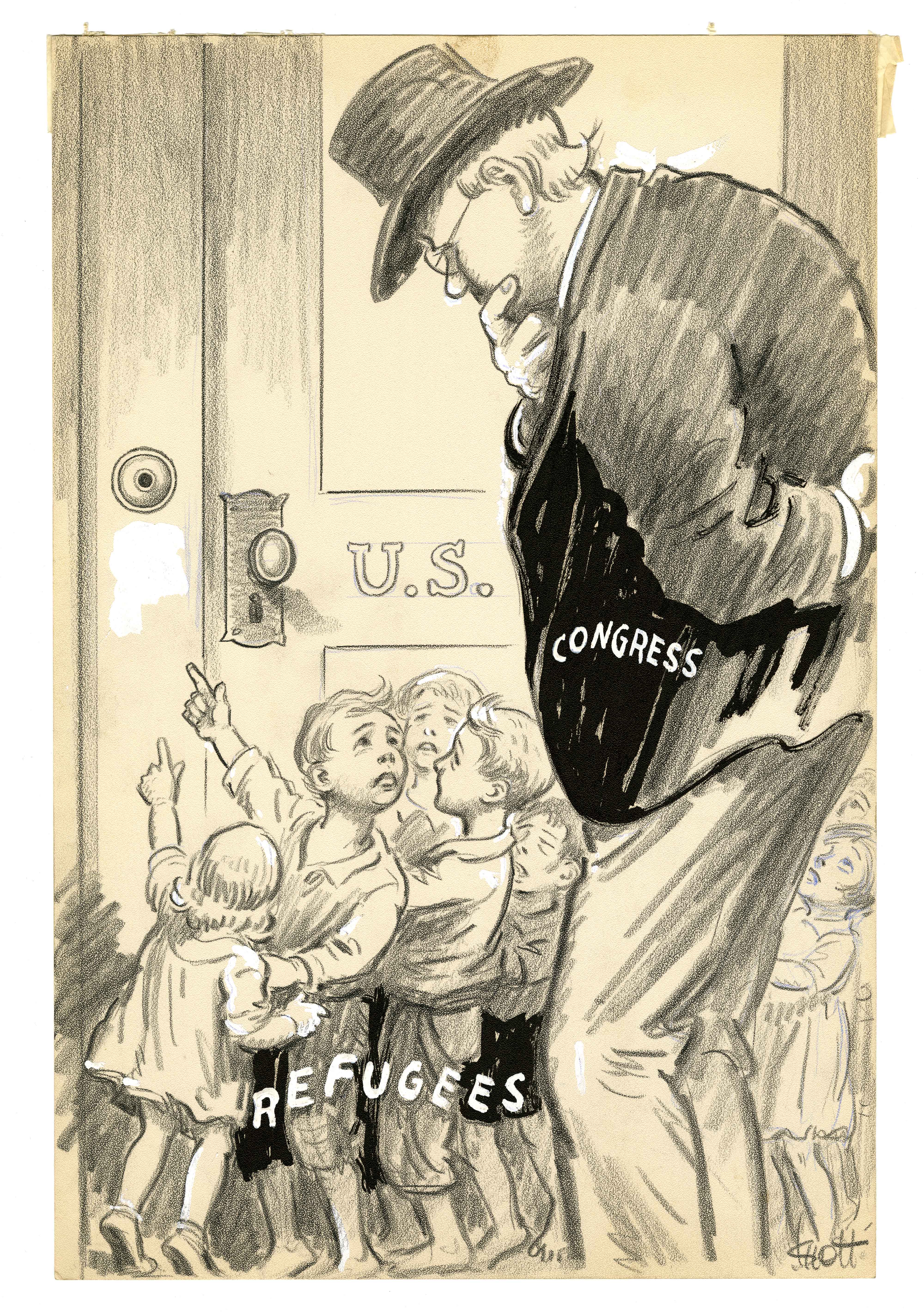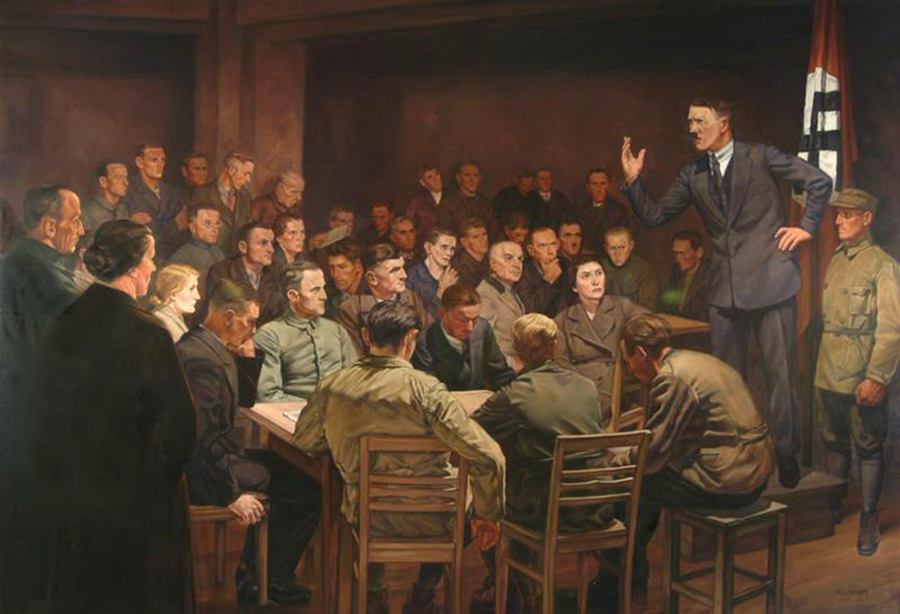Nazi Propaganda exhibition to open at the Bullock
Texas artifacts, Butterfly Project and unique programs round out new exhibition
August 26, 2016 (AUSTIN, TX) — State of Deception: The Power of Nazi Propaganda, a new exhibition opening at the Bullock Texas State History Museum Sept. 17, 2016, examines how Nazi leaders harnessed propaganda in bold and unprecedented ways with devastating results abroad and at home. The exhibition includes rare artifacts from the United States Holocaust Memorial Museum, historical film footage and first-person interviews that explore the impact of propaganda on millions of men, women and children across Germany and Europe. It examines how the Nazis used propaganda to win broad voter support in Germany’s young democracy after World War I, implementing radical programs under the party’s dictatorship in the 1930s, and to justify war and mass murder.
"The Bullock Museum is honored to work with the US Holocaust Memorial Museum to bring this important exhibition to Texas," Director Dr. Victoria Ramirez said. "We are grateful to the USHMM staff for supporting our partnership with the Dallas and Houston Holocaust museums and private collectors to augment the exhibition with additional artifacts and materials."
The Nazi Party’s strategic propaganda campaign relied heavily on early 20th-century technologies to spread its messages. Movies, recordings, and radio broadcasts with clear and simple messaging and bold designs were used to appeal to the masses.
Exhibition artifacts include the inexpensive "People’s Receiver" (Volksempfänger) used to transmit propaganda messages directly into homes, an anti-Semitic coloring book widely distributed to German children to help attract a young audience to the party, a special edition of Mein Kampf issued to newlyweds, and various propaganda posters.
"We're excited to bring this timely exhibition and programming to Texas," Dr. Steven Luckert, curator of the USHMM's State of Deception traveling exhibition said. "Today we are constantly bombarded by messages of all types. We need to learn how to critically evaluate the information we receive, and learning about the past can help us do so."
Bullock Museum staff conducted research and identified additional rare artifacts, photographs and documents from Texas lenders, as well as first-person narratives, to complement the USHMM exhibition.
Artifacts that show the use of various media to spread the Nazi Party’s message include movie, Jud Süss, considered one of the most anti-Semitic films of all time; an edition of Der Stürmer, the weekly German-language tabloid best known for its effective anti-Semitic caricatures; a textbook, The Jewish Question in Classroom Teaching, which taught the Nazi ideology to school children; and many others.
When visitors enter the museum, they will see a large-scale art installation, called the Butterfly Project, which will display thousands of unique and beautiful paper butterflies suspended in the museum's lobby. This project initiated by the Bullock Museum with St. Edwards University will be installed Sept. 11, 2016, and features butterflies created by children from every corner of Texas who were inspired by the poem The Butterfly, written in 1942 by a young man imprisoned in Terezin, Germany. The butterflies represent endurance, change, hope, and life.
"We want to encourage Texans of all ages, but especially young people, to take a stand against intolerance," Ramirez said. "The Butterfly Project offers children a creative way to express themselves and their opinions of the world."
To accompany State of Deception, the Bullock Museum also has curated a companion exhibition, On the Texas Homefront, which examines the consequences of Nazi propaganda in Texas. Original artifacts, news articles, editorial cartoons, historical film footage, artwork and first-person narratives offer a new perspective on how propaganda was used in Texas during the first part of the 20th century.
Visitors will see original artwork from a Dallas Morning News editorial cartoon that shows what Texans were reading in their newspapers. Oral history clips of those placed in Texas internment camps document how the United States reacted to perceived threats of internal espionage during the war by incarcerating its own population. Other audio clips will show the emotional reactions of Texans stationed in Europe who were among the first US troops to arrive and liberate survivors from German concentration camps.
First Lady Eleanor Roosevelt’s handwritten notes on the preamble to the Universal Declaration of Human Rights, the milestone document in the history of human rights that resulted in part from experiences during WWII, is also featured in a document on loan from the Franklin D. Roosevelt Presidential Library in New York.
"On the Texas Homefront answers the question that many people have about Nazi-era Germany – what was happening in the United States during the war?" Ramirez said. "The collection of artifacts in the exhibition not only answers that question, but also shares the deeply-personal artifacts collected by Texans."
Located in the Museum’s Herzstein Hall, the two exhibitions conclude with a thought-provoking space dedicated to creating messages of hope and inspiration for the future.
The first public program held in conjunction with the new exhibitions, Fueling Extremism in a Wired World, is slated for Wednesday, Sept. 28, at 7 p.m. at the museum. Presented jointly by the Bullock Museum and the USHMM, Luckert and a panel of experts will discuss the intersection of extremism and media throughout history and in today’s digital age as they look at the question of how technology allows extremists to spread hatred and prey upon the young and vulnerable.
"Radio was the Internet of its day," Luckert said. "The Nazis viewed it as one of the most modern and important tools for mass persuasion not only in Germany, but throughout the world. This program will look at how the Nazis effectively used technology and what it can teach us about propaganda today."
Both exhibitions will be on view through Jan. 8, 2017. A full list of programs and events can be found at TheStoryofTexas.com.
Education programs sponsored by Lisa and Sandy Gottesman.
Sponsored by the Albert and Ethel Herzstein Hall Fund and Jeanne and Michael L. Klein. Additional support by the Stanford and Joan Alexander Foundation, the Pearlman Family Foundation, and the Friedel Family Foundation.
Support for the Bullock Museum’s exhibitions and education programs provided by the Texas State History Museum Foundation.
State of Deception: The Power of Nazi Propaganda was produced by the United States Holocaust Memorial Museum.
This exhibition was underwritten in part by grants from Katharine M. and Leo S. Ullman and The Blanche and Irving Laurie Foundation, with additional support from the Lester Robbins and Sheila Johnson Robbins Traveling and Special Exhibition Fund established in 1990 and Dr. and Mrs. Sol Center.
The Butterfly Project is a collaboration between the Bullock Museum and St. Edward’s University.
Downloads
The Bullock Texas State History Museum, a division of the State Preservation Board and an accredited institution of the American Alliance of Museums, creates experiences that educate, engage, and encourage a deeper understanding of Texas. With dynamic, award-winning exhibitions that illuminate Texas history, people, and culture, educational programming for all ages, and an IMAX® theater with a screen the size of Texas, the Museum collaborates with more than 700 museums, libraries, archives, organizations, and individuals across the world to bring the Story of Texas to life. For more information, visit www.TheStoryofTexas.com
Media Contact
| General Inquiries | |
|---|---|
| 512-463-5424 | |

